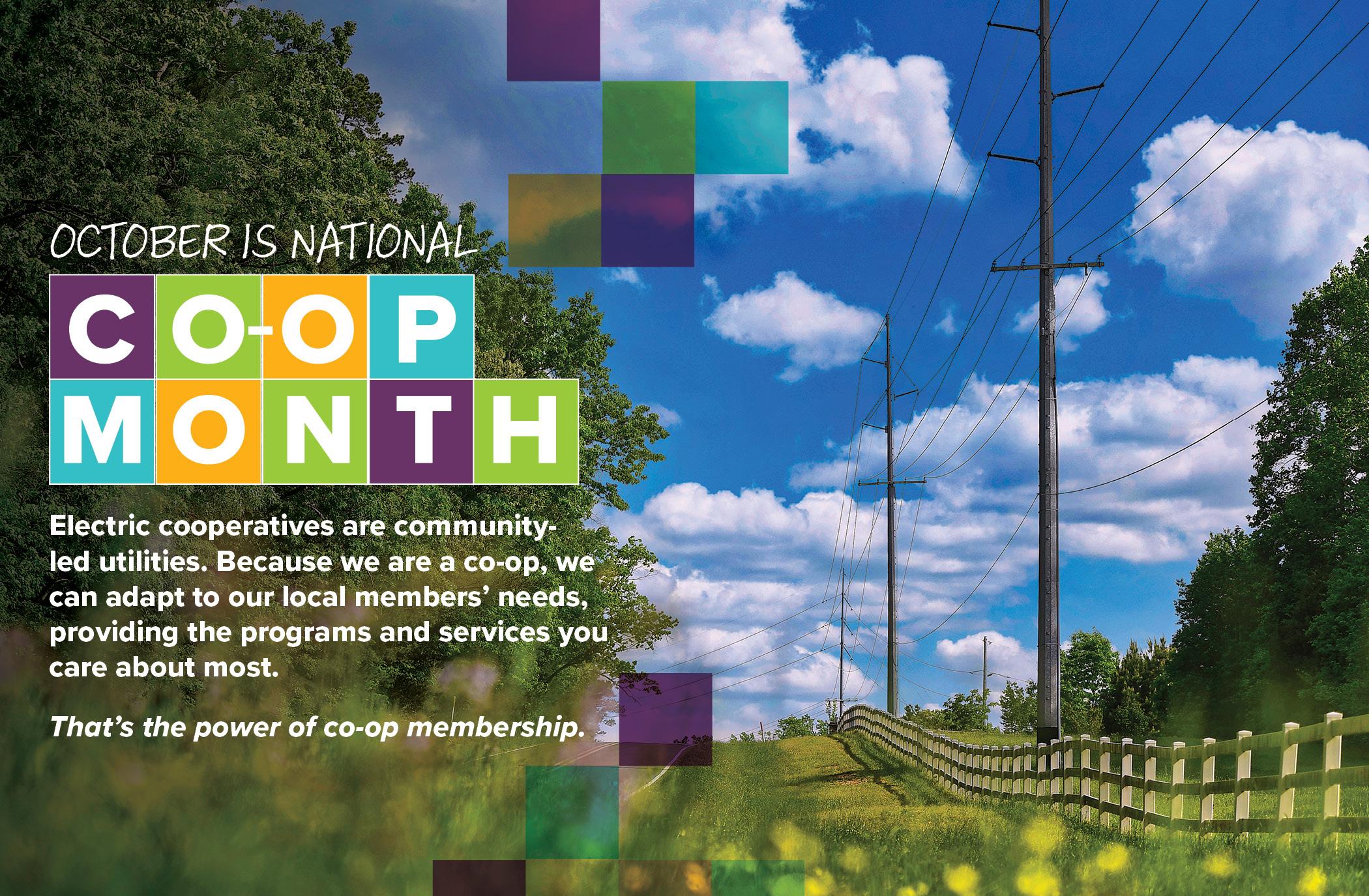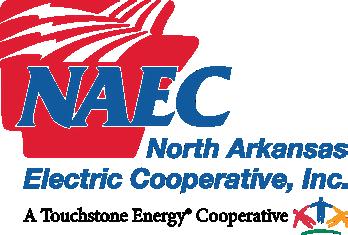
MEL COLEMAN CEO


MEL COLEMAN CEO
North Arkansas Electric Cooperative (NAEC) is deeply committed to our members, and we’re glad you are part of the electric cooperative community. This month, more than 30,000 cooperatives across the U.S. are celebrating National Co-op Month. It’s a time to reflect on all the aspects that set cooperatives apart from other types of businesses, but more importantly, it’s a time to celebrate the power of co-op membership.
Electric cooperatives are built by the communities we serve. Our mission has always been to provide you with Reliable, Affordable and Responsible power. We care about your quality of life, and because we are locally operated, we’re uniquely suited to meet our members’ evolving energy needs.
Beyond the business of electricity, our employees and directors are equally invested in our local community. Why? Because we live here, too. That’s why we work hard to support local economic development projects, youth programs, charitable giving initiatives and additional programs that make our community a better place to call home.
All co-ops are guided by seven cooperative principles that embody the values and spirit of the cooperative movement. These seven principles are a framework to help all co-ops navigate challenges and opportunities while remaining true to our purpose:
1. Open and Voluntary Membership: Co-op membership is open to anyone who can use the co-op’s services.
2. Democratic Member Control: Members make decisions that shape the cooperative. Why? Because co-ops are created by the members, for the members.
3. Members’ Economic Participation: Members contribute money by paying monthly bills to the co-op to make sure it runs smoothly now and in the future.
4. Autonomy and Independence: Co-ops are independent and can operate on their own, which ultimately benefits the members.
5. Education, Training and Information: Co-ops continuously focus on education to ensure employees have the training and information they need to make the co-op successful.
6. Cooperation Among Cooperatives: Co-ops share with and learn from other cooperatives. We help each other out in times of need because we want other co-ops to thrive.
7. Concern for Community: All cooperatives work for the greater good of the local communities they serve. Co-ops give back to their communities to help them thrive and grow.
This October, as we celebrate National Co-op Month and the power of membership, we hope you will recognize the many aspects that set electric cooperatives apart. Our mission is Reliable, Affordable and Responsible power. Our purpose is people –– the local communities we’re proud to serve.

The average household with internet access owns about 17 connected devices. That figure covers a wide range of electronics, including smartphones, computers, streaming devices, smart speakers, home assistants and more. Given our increasing reliance on internetconnected technologies, the likelihood of new cyber threats is ever-present.
North Arkansas Electric Cooperative is deeply committed to ensuring our local system is safe and secure. We routinely monitor and manage cyber risks, and we work together with other co-ops to share the latest advancements in cybersecurity measures that make us stronger. And you can help, too.
When we all work together to stay safe online, we lower the risk of cyber threats to our systems, online accounts and sensitive data.
Magician Scott Davis teaches 4-H Kids College attendees how to stay safe around electricity through his "Making Accidents Disappear" show at Ozarka College in Ash Flat. The Electric Cooperatives of Arkansas sponsor the show across the state.

October is National Cybersecurity Month, and while good cyber hygiene should be practiced year-round, we’d like to share a few cybersecurity tips to help you bolster your online safety.
• Learn how to spot and report phishing attempts. Phishing occurs when criminals use phony emails, direct messages or other types of digital communications that lure you to click a bad link or download a malicious attachment. If you receive a suspicious email or message that includes urgent language, offers that seem too good to be true, generic greetings, poor grammar or an unusual sender address, it could be a phishing attempt. If you spot one, report it as soon as possible –– and don’t forget to block the sender. If you receive a suspicious work email, report it to the appropriate IT contact. Suspicious messages that are delivered to your personal email or social media accounts can also be reported.
As you prepare for hunting season, keep in mind that along with general hunting safety, electrical safety should be a priority.
You might be preoccupied and excited about the big hunt, but be aware of power lines. Never place a tree stand on a utility pole or near a power line. Energized lines and related equipment on utility poles can conduct electricity to anyone who comes in contact with them, causing shock or electrocution.
It is illegal to shoot near or toward power lines, utility poles, transformers or substations. Stray bullets or pellets could damage equipment, possibly interrupting electric service and causing physical risks to those nearby or line personnel forced to make repairs.
• Create strong, unique passwords. When it comes to passwords, remember that length trumps complexity. Strong passwords contain at least 12 characters and include a mix of letters, numbers and symbols. Create unique passwords for each online account you manage, and use phrases you can easily remember. Many services will allow you to use sentences and phrases as your password.
For your safety, follow these additional electrical safety tips:
• Familiarize yourself with the area before heading out to hunt. Take note of power lines and equipment, especially when hunting in densely wooded areas.
• Enable multifactor authentication when available. Multifactor authentication (also known as two-factor authentication) adds an extra layer of security to your online accounts. These extra security steps can include facial recognition, fingerprint access or one-time codes sent to your email or phone to further identify you after successfully entering your username and password.
• Observe all signs or postings that advise electrical safety, especially when scouting out a location for your tree stand.
• Look up and look out for power lines, and do not come within 10 feet of an overhead line or pole when setting up or taking down a stand.
• Never climb a utility pole.
• Update software regularly. Software and internet-connected devices, including personal computers, smartphones and tablets, should always be current on updates to reduce the risk of infection from ransomware and malware. When possible, configure devices to automatically update or notify you when an update is available. For personal computers or laptops, check for updates to any applications installed. These settings are usually found within the applications.
• Do not place dove decoys on power lines or other utility equipment. Nonelectrical attachments can pose an obstruction and serious hazards to our lineworkers.
Let’s all do our part to stay cyber smart and create a safer digital world for all. Visit staysafeonline.org to learn about additional cybersecurity tips.
For more information about safety around power lines and other sources of electricity, go to safeelectricity.org.

(870) 895-3221 (844) 335-4461 NAEC App naeci.com ▶ Outage Viewer
NAEC Twitter.com/NorthARElectric Facebook.com/NorthARElectric NAEC's offices will be closed Sept. 2 in observance of Labor Day. A dispatcher will be on duty, and personnel will be on call in the event of an outage. Report an outage to the NAEC app or (870) 895-3221.

BY MITCH ROSS
Several years ago, when I was looking to purchase a home for my family, I gave the real estate agent quite a surprise! As she was showing us a home and talking about the layout and other hottopic items, an attic access caught my eye.
Though I didn’t have a ladder, and it wasn’t a pulldown style access, I was undeterred. I grabbed a broom to push the scuttle door out of my way and managed to jump up and grab the lip of the scuttle hole and pull myself up. I’m not 100% positive, but based on the agent’s reaction, I’m guessing this is the first time she’d experienced something like that.
The most notable thing that came out of this attic review was the dire lack of insulation. If we purchased the home, I was going to have some expense on my hands to get the insulation where it needed to be to make the home comfortable and efficient. We bought the house, and I put in blown cellulose insulation soon after we moved in. We noticed the difference it made right away!
The experience also reminded me of how many insulation options there are for homeowners, and how investigating and choosing the best option for a particular application can be tricky. The most important part of the home to insulate well is the attic, as that is where most heat transfer occurs in homes.
Here are some common insulation materials and considerations for each:
Fiberglass batts: These rolls of fiberglass insulation are the most common for DIY scenarios, as they are relatively easy to install and don’t require any special equipment. They come in varying thicknesses for different applications (walls vs. ceilings). However, if great care isn’t taken to install them well with no gaps, the R-value, or measure of thermal resistance, drops significantly.
Blown fiberglass: This loose material requires a machine for installation. It is good for attics, as installation goes quickly and covers small areas and gaps well. It’s usually not the best option, in my opinion, as blown cellulose offers the same benefits plus some others at a comparable cost.

Blown cellulose: This is usually the best-value option for homes, especially in the attic. It is composed of recycled paper with some fire-retardant additives. It has the same pros as blown fiberglass and is installed in the same manner. The big benefit of this material over fiberglass is that it is significantly better at stopping airflow in addition to slowing heat transfer.
Spray foam: Spray foam is your premium option for insulation. It has excellent R-value per inch and completely cuts off airflow. It requires professional installation and has a high price tag. There are closed-cell and open-cell options depending on your application.
Whenever considering attic insulation options, be sure to do your homework, as you’ll be feeling the effects for years to come!
Mitch Ross is the energy efficiency manager for the Electric Cooperatives of Arkansas.